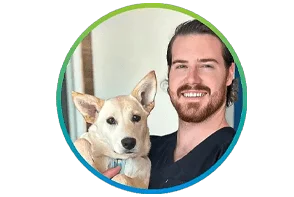PET CARE
My Dog Ate A Bee, Now What?
Does your dog jump after flies and moths, or try pouncing on spiders? Dogs often explore their environments with their mouths, which can sometimes result in swallowing something dangerous — like a bee. If you think your dog swallowed a bee, you’re probably wondering what will happen next. The answer depends on whether or not the bee stung your dog on the way down. Let’s take a look at some of the risks and consequences of dogs eating bees.
What Happens if a Dog Eats a Bee?
In most cases, dogs eating bees isn’t inherently dangerous.1 As long as the bee is swallowed without stinging, it should be digested with no lasting harm to your pup. At worst, this might cause your dog to vomit.
The real danger comes from the risk of your dog being stung while they attempt to eat the bee. Swelling in the throat or mouth could make it difficult for them to breathe, turning a spicy snack into a real medical emergency.1 If you notice any swelling around the mouth or throat, along with difficulty breathing, bring your dog to the vet right away.
Does Your Dog Eat Things They Shouldn't?
Why do dogs eat bees?
Some dogs, such as pointers or Labrador retrievers, have been bred to focus on movement. Others might simply be attracted by the buzzing of a bumblebee. It’s even possible for some dogs to develop “fly-snapping,” a Canine Compulsive Disorder (CCD) that causes them to bite at imaginary flying insects.2 Whatever the reason, a dog’s curiosity plus their tendency to explore with their mouths is a potent combination that often ends with swallowed bugs — including bees!
Signs Your Dog Has Been Stung by a Bee
When a bee stings, it injects a small amount of venom, which is what causes the pain.1 This can be similar to when a dog is bitten by a spider. If your four-legged friend is stung by a bee, you may notice swelling and sensitivity to touch in the general area.1 Signs that your dog was stung in the mouth may include:1
- Drooling
- Coughing
- Gagging
- Frequent lip licking
- Difficulty breathing
If you know your dog was stung by a bee, monitor them over the next 24 hours for any of these signs. In the meantime, there are some steps you can take to mitigate their discomfort, such as locating and removing the stinger and applying a cold pack to the site of the sting.
When Is a Bee Sting Considered Serious?
Multiple bee stings can increase the risk of a dangerous reaction — and in some cases, may even cause your dog to go into shock or suffer damage to internal organs.1 Additionally, some dogs can have severe allergic reactions to bee stings. Symptoms of an allergic reaction can include:1
- Hives
- Weakness or lethargy
- Wheezing or difficulty breathing
- Extensive swelling beyond the sting site
If you already know your dog is allergic to bee stings, call your vet as soon as you suspect your pup has suffered a bee sting. If your dog has never been diagnosed with a bee allergy but is still displaying these symptoms, you should still get them to a vet as soon as possible.
Bee Prepared With Pet Insurance
While most bee stings cause dogs only mild discomfort and swelling, it’s always better to be on the safe side.1 Contact your vet and observe your dog for signs of an allergic reaction for 24 hours following a sting. You should prevent your dog from licking and scratching at the sting area, as this can interfere with healing. Remember, bees can get trapped in the fur and coats of dogs, so make sure to check your pup when they come in from the outdoors.
Another way to prepare for bee stings and other accidents is with a dog insurance policy. It could help you save money on the cost of treatment.
Don’t wait for your own bee-mergency to protect your pup. Get started today with a free pet insurance quote from MetLife Pet.
Pet Insurance Can Help Cover Bee Sting Costs
Dr. Hunter Finn has been paid by MetLife to discuss the importance of choosing pet insurance. He is an integrative veterinary expert first, and social media star second. America’s favorite veterinarian owns Pet Method in McKinney, Texas, where he cares for pets while prioritizing their emotional well-being. When he’s not at his clinic, he’s starring in viral videos on TikTok (2 million followers) and Instagram (500K followers) — where he’s been known to snuggle puppies and conquer the latest dance trends.


